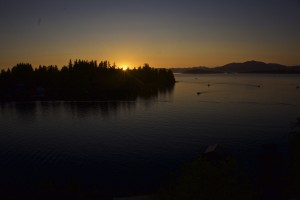After quite a journey from Boston to Bamfield Marine Science Centre, I had finally settled down and unpacked my bags for a three and a half week stay on Vancouver Island. Sunday morning I woke up, ate breakfast and proceeded to head over to the lab where Sara’s experiment was set up. Every day in the morning and in the evening, Sara has to take the temperatures of all 16 of her trial buckets and the feeder buckets, as well as monitoring flow rate and oxygen levels. The fish are also fed twice a day and plankton/copepods need to be gathered every day for the hungry little rockfish and feeding patterns are observed at least once a day. It’s quite the labor-intensive project, but I’m glad I can be an extra hand in the lab. Around 11 we met up with Katie and Chett (her husband) to head to the nearby town of Pachena for aboriginal day! The fisheries class had some field work at the bay and so we watched them scouring over the exposed sand flats for various fish and practice throwing a seine net. We then relaxed and chatted while waiting for lunch to be served. The evening was spent back in the lab, going through the temperatures, fish feeding, and other random trouble shooting that comes up with such a hands on project. To end the day, we headed out to one of the observation decks overlooking the sound to be greeting with not only a gorgeous sunset (I think Canada was flirting with me!) and a mother humpback whale and her calf playing out in the sound.
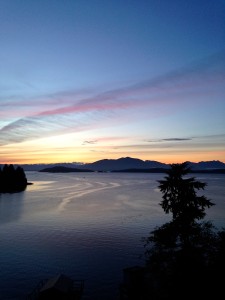
Monday morning I had the chance to “sleep in” – whatever that is – because Katie, Sara, and Stephanie went out to collect fish for their study and didn’t have room for me on the boat. But always the busy body, I had some errands to run so couldn’t spend too much time relaxing! After eating breakfast and sending a few emails, I headed in to East Bamfield (Bamfield is divided across an inlet into East and West Bamfield. There is no road connecting the two, you have to use some form of boat to get from one side to the other). I wanted to talk to a guy who runs a local dive shop, but he was out doing a taxi run so I turned back towards the research station. I then got ahold of Siobhan, the DSO, to arrange a check out dive (finally getting in the water!) and then I decided to make the rowboat trip over to West Bamfield to get some groceries. Apparently, it’s quite the sight to watch the new folks attempt to row these little boats across the small inlet. Luckily for me, I rowed for a year at USC and wasn’t too intimidated by the idea. I grabbed Chett and their baby, Isaac, and we began the journey to the West side. Just as I anticipated, rowing the boat was not nearly as difficult as people made it out to be, but docking it was definitely a bit trickier than I thought it would be. After a quick shop to stock up for the upcoming week, we loaded up the rowboat and headed back to the research station. By this time the girls had come back from their collection trip with loads of fish and were in the lab recording each one as well as catching up on the morning tasks. I jumped in to help lighten the load and we finished just around dinnertime. Chett had cooked us a delicious vegetable soup and cornbread and after chowing down, we headed right back to the lab to do the evening measurements.
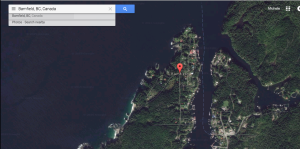
Tuesday was an early morning in the lab, and although the three of us had established a fairly efficient routine, there are always small problems that pop up and have to be dealt with. Despite having a lot of work to get through in the morning, one little routine we established, which I’ve come to really enjoy, is taking a coffee break around 10 to grab coffee and either scones or muffins from the cafeteria. After a small break and more caffeine, we head back to conquer the rest of our morning with more energy than when we began. After lunch and a small nap, I headed down to the dock to meet with Stephanie to do the plankton tow. With 60 new mouths to feed, there was a need for more copepods and longer towing! We spent the evening towing and managed to get a good amount of critters. Then back up to the lab to help Sara with the rest of the tasks. After just a few days of helping out in the lab, I’ve come to really respect the patience and perseverance of scientists, who are constantly faced with problems and failures, but continue to push ahead in pursuit of finding answers.
By Wednesday we had settled into a relatively consistent pattern. Meet in the lab in the morning to begin the daily routine. But this morning, we were thrown a curve ball. Two of the seawater hoses pumping seawater from the inlet to the lab had clogged so one of the feeder buckets was completely drained and the heater had melted a hole through the bucket. Thank goodness nothing more serious had happened! But it was another setback to overcome and Sara was able to rig another bucket together and use their spare heater. After a longer, more frustrating morning than usual, we headed for lunch and an afternoon break. The rest of the day went as usual, with more lab work in the evening and another beautiful sunset after we finished all our work. We decided to make a tradition of watching whatever is left of the sunset after we finish lab work each evening. It’s a wonderful chance to unwind from the day, relax, and chat.
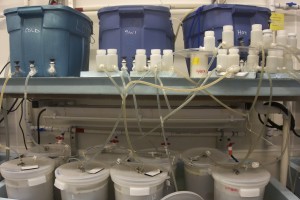

Thursday was a big day for me – I was finally doing my check-out dive that afternoon and I couldn’t be more excited to get in the water! The morning was the same old routine of doing lab work and measurements. After a quick lunch, I grabbed all my dive gear and headed down to the dive locker where I’d meet up with Siobhan, the DSO, and the other student doing a checkout dive. Sara decided to tag along and just spend the afternoon enjoying being out on a boat. We spent a bit of time going over what we were doing for the days, which included some basic skills and a rescue scenario, then we familiarized each other with our gear and the dive locker. We threw our kit together, donned our drysuits, loaded the boat and went on our merry way. Chad, the assistant DSO, was our tender for the day and he drove us over to Ross Island, a small island just across Barkley Sound, where we would be doing our dive. After a dive briefing, we got geared up and hopped in the water. It was incredible to be back in the water again! I was stoked to be diving and just the slightest bit nervous for the rescue drill (it had been a long time since my rescue course). We submerged down to around 20 feet and found a clearing in the sand amongst the urchins and sea cucumbers. We then proceeded to go through basic drills such as mask clearing/removal, weight ditch, gear removal, the drysuit roll, regulator removal and recovery, so Siobhan could get a feel for our skill level and comfort in the water. After completing the skills we did a mini tour of the area, looking for a Giant Pacific Octopus den and we then moved to an area to do the rescue drill. The premise of the scenario was that we had come across an unresponsive diver and as we bring them up to the surface and back to the boat, Siobhan would give more details to the situation and we would have to react accordingly. I did much better than I expected I would and didn’t feel stressed at all. If there is one thing I’ve learned through all my safety training, it’s that you need to keep calm and move slowly, but with a sense of deliberation. The more you try to rush through the process, the more flustered you usually get and the more mistakes you tend to make. After I completed my drill (including using parbuckles to roll the patient on the boat, which was really fun and easy) Siobhan debriefed everything, giving me a few pieces of constructive feedback, then we hopped back in the water for the other student, Neha, to be the rescuer. After Neha completed her rescue drill, we settled back on the boat and headed back to the research station, all the while scanning the horizon for whale spouts. We had made it 2/3 of the way across the sound when Chad (who at this point in the day had earned the nickname Dad) spotted a whale spout just behind us. We slowed the boat and maneuvered to where we thought the whale would be heading and waited, scanning for more spouts. Unfortunately the whale decided to travel in the exact opposite direction that we needed to be going so after a few minutes of anticipation, we decided to head back to Bamfield and make a quick side stop at the West side for ice cream. There is nothing better than ice cream after diving and it was a perfect post-check-out treat. We then docked back at the research station, washed down our gear and put things away in our lockers. After a fast dinner, we met back in the lab to do more work for the evening, finishing at a reasonable hour tonight (around 9:45 pm) and then heading off for our sunset viewing.
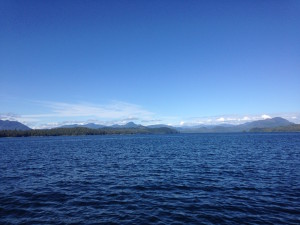
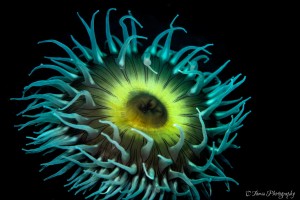
Friday was going to be a busy day because we needed to clean all 16 of the fish buckets in addition to our usual tasks. We met in the lab a bit earlier that morning and pushed through gathering all the temperature data. We then set up for the bucket cleanings – while each bucket was drained and cleaned, the fish would be measured, photographed, and weighed to see how they had grown over the past week in their treatments. Steph and I were doing the measuring, photographing and weighing while Sara drained, cleaned, and refilled the buckets. We knew we had a lot of work ahead of us so buckled down for a long morning. Things surprisingly went smoother and faster than we anticipated and after only an hour and a half we had cleaned 8 of the 16 buckets. It was around this time that another grad student working in the lab came in and told us that the Bamfield marmot was out and about! Over the past week or so, people had been noticing a juvenile marmot hanging around the research station. This is awesome for two reasons: marmots are one of the most endangered species in Canada AND they are usually only found in the alpine regions, not the coast. So to have one hanging around the station was quite a rare situation! We took a brief hiatus from cleaning to take a peek at the fuzzy little guy, who was sunbathing on a cement block. He clearly enjoyed the attention of us ladies, as he didn’t budge as we quietly edged closer to him and he even gave us a few model poses that we snapped with our phones. What a ham! But we couldn’t stay and flirt with the little guy for long, as lab work beckoned us back. We pushed on through and managed to clean the second half of the buckets without incident and in a reasonable time frame. That afternoon I spent a few hours on the observation deck, catching up on my journal and writing a few letters, all while soaking up some rays. The day ended with our usual time spent in the lab and another peaceful sunset.
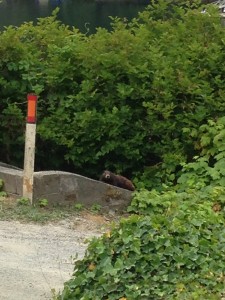
Saturday was a day for the record books. Little did I know of the excitement and adventure in store for us. Sara and I had been trying to go on a hike or snorkel for 5 days at this point and we had decided to hike a section of the West Coast Trail that afternoon, once our morning lab work was finished. We quickly got all the work done, then packed a lunch, water, and our cameras and met up with Katie to drive over to Pachena, where the trail head is. The trail winds along the west coast of the island, taking us through beautiful forests and stands of trees, dappled with the sunlight pouring down. It was a beautiful day to be hiking. The sun was out but it wasn’t overbearingly hot. The forest provided enough shade and coverage so the sun didn’t scorch us. We trekked around 9 km (5.5 miles) through the scenic woods to a sea lion rookery on the coast.
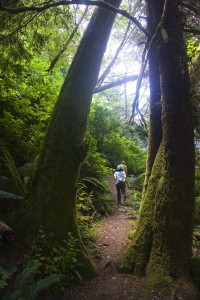
About a kilometer before the rookery, we had a glimpse of the ocean between the trees and to our delight, we saw a pod of 4 or 5 whales hanging right off the coast. We grabbed our cameras, desperate to get a few shots of them through the trees. We could just hear the sea lions in the distance and reluctantly decided to just go all the way to the rookery with the hopes we’d be able to still see those 4-5 whales. Little did we know what Mother Nature had in store for us. Upon reaching the rookery not only could we still see the 4-5 whales, with an open view of the entire coast line, we could see the pod in its entirety.
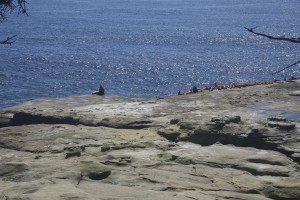
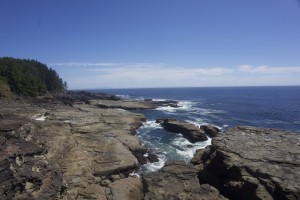
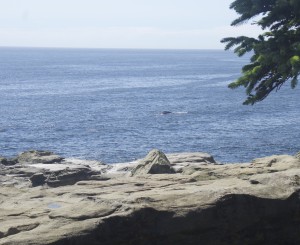
There were at least 15-20 whales stretched up and down the entire coastline. Some were far offshore, but some were just meters off the rookery, much closer than I expected these behemoths to be to the shoreline. It was an amazing sight to see. No matter where you looked, you saw the spouts of the whales and the tops of their backs as they gracefully dove back down into the water. But what was even more incredible was the 3-4 whales that were right on the shoreline. Each time they surface for air, you could see almost their entire body and it was astounding to see how big they are. What beautiful creatures! We spent over an hour at the rookery, trying to film and photograph the pod and capture the moment. It was such an incredible afternoon and the most pleasant of surprises. The pure luck of heading to the rookery at the same moment such a big pod of humpbacks was feeding made it such a special afternoon. After sitting and watching and reveling in these giants for over an hour, we sadly decided to pack back up and head back to the research station. We had another 5.5 mile hike back to the trailhead, but it seemed to fly by as we were all still in awe of what we had just seen. We got back to Bamfield, wolfed down a fast dinner, then headed back to the lab to do the evening measurements. Upon finishing, we all quickly changed then headed over to the West side to make our fashionably late appearance at an annual party held in honor of upcoming Canada Day. All in all it was an amazing day and Canada has been pulling out all the stops to “whale-come” me to the beautiful Vancouver Island.
